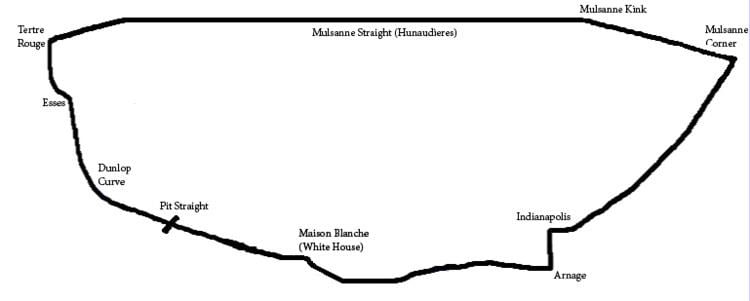 | ||
The 24 Heures du Mans was the 28th 24 Hours of Le Mans, Grand Prix of Endurance, and took place on 25/26 June 1960, on Circuit de la Sarthe. It was the fifth and final round of the F.I.A. World Sports Car Championship. It was also the fifth round of the inaugural FIA GT Cup. Some 200,000 spectators had gathered for Europe’s classic sports car race, around an 8.36-mile course. The prospect of an exciting duel between the title contenders Ferrari and Porsche was enough to draw large crowds to the 24 Hours race.
Contents
Entry
Just 73 racing cars were registered for this event compared to the 97 for 1959, of which only 58 when allowed to practice, trying to qualify for the 55 places for the race. The number of starters increased by one for this race, from the 54 of previous years.
With last year’s winner Aston Martin having moved onto Formula One, the race should be Scuderia Ferrari’s for the taking, despite being behind Porsche in the championship standings. The Italian outfit, together with a numerous privateer teams would have 13 Ferrari 250s, in different guises and classes, to take the title fight to the Germans. The works squad of drivers included 1958 winners, Phil Hill/Wolfgang von Trips, and they were joined by Willy Mairesse/Richie Ginther and Olivier Gendebien/Paul Frère. Interestingly, prior to this race, Gendebien was raced for Porsche.
Ferrari’s main challenge would come from a number of sources. Porsche, Maserati and even Corvette. As championship leader, Porsche should have be consisted among the favourites although their cars ran in a smaller class than their Italian rivals, but with drivers of the calibre of Jo Bonnier and Graham Hill, could they take the spoils. As for the Americans, the Corvettes were entered in the same class as the Ferraris, the cars were much heavier and bulky then the European sportscars, but they would have an advantage – their engines.
Qualifying
Qualifying was held over two sessions for a total of 540 minutes over the 22 and 23 June, a few days prior to the race.
Race
The Ferraris and Maseratis would be fast right from the off, but wouldn’t be matched by reliability, whereas the Corvettes and Porsches would carry on early on within any problems. With the American cars, this went against the opinion of many who though their heavy cars would suffer from brake issues on the tight corners like at the end of the long Mulsanne Straight. Not only were the Ferraris fast, they were also much reliable than some of the other marques, although their lead 250 TR 59/60 of Hill and von Trips was the first to retire when it ran out of fuel, on lap 22. Their team-mates, Ludovico Scarfiotti and Pedro Rodríguez would also exit the race on the same lap.
With the remaining Ferraris controlling the pace, the Corvettes wouldn’t be that far back. However, the overcast skies the welcomed the start had turned to heavy rain by 6pm and would cause absolute chaos as the circuit began to flood. Around Maison Blanche, William Kimberley would lose control of his Corvette and it would somersault and catch fire. Shortly after, his team–mate, Fred Windridge would bounce of the embankment lining the track, again at Maison Blanche. Windridge was able to get the car back to the pits repairs.
The Ferraris continued to lead during the worse of the rain, whilst there was one car actually making up ground. That was the Corvette of John Fitch. He was driving like mad, and in a span of four hours, he would make his way from 13th up to 7th.
By Sunday morning, the rain had cleared and the sun was shining. Ferrari remained in a strong position and would go on to win the race and the world title, while all three works Porsches would be out of the race.
The winning partnership of Gendebien and Frère, averaged a speed of 106.201mph, and their winning margin over the second placed crew was four laps, driven by Ricardo Rodríguez and André Pilette. A further four laps adrift was the 1959 winner Roy Salvadori, partnered by a promising young Scottish driver, Jim Clark in an Aston Martin DBR1/30. They were the only non-Ferrari in the top seven.
Official Classification
Class Winners are in Bold text.
Not Classified
Failed to complete final lap under own power.
FIA World Sportscar Championship
Championship points were awarded for the first six places in each race in the order of 8-6-4-3-2-1. Manufacturers were only awarded points for their highest finishing car with no points awarded for positions filled by additional cars. Only the best 3 results out of the 5 races could be retained by each manufacturer. Points earned but not counted towards the championship totals are listed within brackets in the above table.
